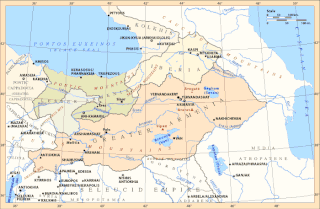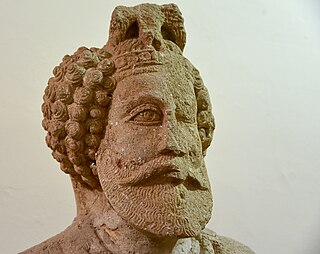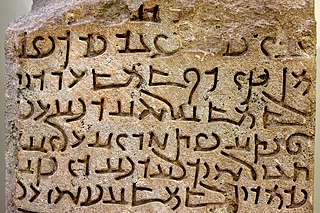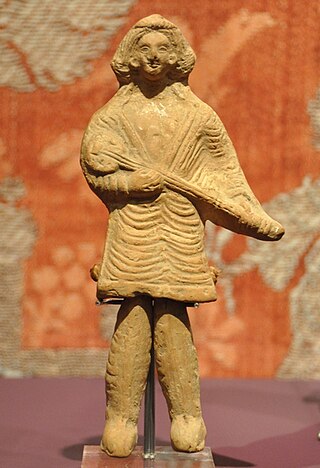
Shapur I was the second Sasanian King of Kings of Iran. The precise dating of his reign is disputed, but it is generally agreed that he ruled from 240 to 270, with his father Ardashir I as co-regent until the death of the latter in 242. During his co-regency, he helped his father with the conquest and destruction of the city of Hatra, whose fall was facilitated, according to Islamic tradition, by the actions of his future wife al-Nadirah. Shapur also consolidated and expanded the empire of Ardashir I, waged war against the Roman Empire, and seized its cities of Nisibis and Carrhae while he was advancing as far as Roman Syria. Although he was defeated at the Battle of Resaena in 243 by Roman emperor Gordian III, he was the following year able to win the Battle of Misiche and force the new Roman emperor Philip the Arab to sign a favorable peace treaty that was regarded by the Romans as "a most shameful treaty".

Hatra (; Arabic: الحضر was an ancient city in Upper Mesopotamia located in present-day eastern Nineveh Governorate in northern Iraq. The ruins of the city lie 290 km northwest of Baghdad and 110 km southwest of Mosul. It is considered the richest archaeological site from the Parthian Empire known to date.

Atropatene, also known as Media Atropatene, was an ancient Iranian kingdom established in c. 323 BC by the Persian satrap Atropates. The kingdom, centered in present-day northern Iran, was ruled by Atropates' descendants until the early 1st-century AD, when the Parthian Arsacid dynasty supplanted them. It was conquered by the Sasanians in 226, and turned into a province governed by a marzban ("margrave"). Atropatene was the only Iranian region to remain under Zoroastrian authority from the Achaemenids to the Arab conquest without interruption, aside from being briefly ruled by the Macedonian king Alexander the Great.

Mithridates I, also known as Mithridates I the Great, was king of the Parthian Empire from 165 BC to 132 BC. During his reign, Parthia was transformed from a small kingdom into a major political power in the Ancient East as a result of his conquests. He first conquered Aria, Margiana and western Bactria from the Greco-Bactrians sometime in 163–155 BC, and then waged war with the Seleucid Empire, conquering Media and Atropatene in 148/7 BC. In 141 BC, he conquered Babylonia and held an official investiture ceremony in Seleucia. The kingdoms of Elymais and Characene shortly afterwards became Parthian vassals. In c. 140 BC, while Mithridates was fighting the nomadic Saka in the east, the Seleucid king Demetrius II Nicator attempted to regain the lost territories; initially successful, he was defeated and captured in 138 BC, and shortly afterwards sent to one of Mithridates I's palaces in Hyrcania. Mithridates I then punished Elymais for aiding Demetrius, and made Persis a Parthian vassal.

Adiabene was an ancient kingdom in northern Mesopotamia, corresponding to the northwestern part of ancient Assyria. The size of the kingdom varied over time; initially encompassing an area between the Zab Rivers, it eventually gained control of Nineveh and starting at least with the rule of Monobazos I, Gordyene became an Adiabenian dependency. It reached its zenith under Izates II, who was granted the district of Nisibis by the Parthian king Artabanus II as a reward for helping him regain his throne. Adiabene's eastern borders stopped at the Zagros Mountains, adjacent to the region of Media. Arbela served as the capital of Adiabene.

Vologases I was the King of Kings of the Parthian Empire from 51 to 78. He was the son and successor of Vonones II. He was succeeded by his younger son Pacorus II, who continued his policies.

Vardanes I was a king of the Parthian Empire from 40 to 46 AD. He was the heir apparent of his father Artabanus II, but had to continually fight against his brother Gotarzes II, a rival claimant to the throne. Vardanes' short reign ended when he was assassinated while hunting at the instigation of a party of Parthian nobles.

Gotarzes II was king of the Parthian Empire from 40 to 51. He was an adopted son of Artabanus II. When his father died in 40, his brother Vardanes I was to succeed to the throne. However, the throne was seized by Gotarzes II. Gotarzes II eventually was able to gain control of most of Parthia forcing Vardanes to flee to Bactria. With the death of Vardanes in c. 46, Gotarzes II ruled the Parthian Empire until his death. Gotarzes II was succeeded by his uncle Vonones II.

Vologases III was king of the Parthian Empire from 110 to 147. He was the son and successor of Pacorus II.

Osroes I was a Parthian contender, who ruled the western portion of the Parthian Empire from 109 to 129, with a one-year interruption. For most of his reign he contended with the rival king Vologases III who was based in the eastern provinces. In 116, Osroes I was briefly ousted from his throne at Ctesiphon during an invasion by Roman emperor Trajan, who installed Osroes' son, Parthamaspates. After Trajan's death the following year, Osroes I's rule was reinstated by the Parthian nobility. In 129, he was removed from power by Vologases III.

Vologases IV was King of Kings of the Parthian Empire from 147 to 191. He was the son of Mithridates V. Vologases spent the early years of his reign re-asserting Parthian control over the Kingdom of Characene. From 161 to 166, he waged war against the Roman Empire; although initially successful, conquering Armenia and Syria, he was eventually pushed back, briefly losing control of the Parthian capitals of Seleucia and Ctesiphon to the Romans. The Romans suffered heavy losses from a plague erupting from Seleucia in 166, forcing them to withdraw. The war ended soon afterward, with Vologases losing most of northern Mesopotamia to the Romans. He died in 191 and was succeeded by his son Vologases V.

Vologases V was King of Kings of the Parthian Empire from 191 to 208. As king of Armenia, he is known as Vologases II. Not much is known about his period of kingship of Armenia, except that he put his son Rev I on the Iberian throne in 189. Vologases succeeded his father Vologases IV as king of the Parthian Empire in 191; it is uncertain if the transition of power was peaceful or if Vologases took the throne in a civil war. When Vologases acceded the Parthian throne, he passed the Armenian throne to his son Khosrov I.

Characene, also known as Mesene (Μεσσήνη) or Meshan, was a kingdom founded by the Iranian Hyspaosines located at the head of the Persian Gulf mostly within modern day Iraq. Its capital, Charax Spasinou, was an important port for trade between Mesopotamia and India, and also provided port facilities for the city of Susa further up the Karun River. The kingdom was frequently a vassal of the Parthian Empire. Characene was mainly populated by Arabs, who spoke Aramaic as their cultural language. All rulers of the principality had Iranian names. Members of the Arsacid dynasty also ruled the state.

The Parthian Empire, also known as the Arsacid Empire, was a major Iranian political and cultural power centered in ancient Iran from 247 BC to 224 AD. Its latter name comes from its founder, Arsaces I, who led the Parni tribe in conquering the region of Parthia in Iran's northeast, then a satrapy (province) under Andragoras, who was rebelling against the Seleucid Empire. Mithridates I greatly expanded the empire by seizing Media and Mesopotamia from the Seleucids. At its height, the Parthian Empire stretched from the northern reaches of the Euphrates, in what is now central-eastern Turkey, to present-day Afghanistan and western Pakistan. The empire, located on the Silk Road trade route between the Roman Empire in the Mediterranean Basin and the Han dynasty of China, became a center of trade and commerce.

The Satrapy of Armenia, a region controlled by the Orontid dynasty, was one of the satrapies of the Achaemenid Empire in the 6th century BC that later became an independent kingdom. Its capitals were Tushpa and later Erebuni.

Sanatruq I was the first king of Hatra, an ancient city in northern Mesopotamia.

Aramaic of Hatra, Hatran Aramaic or Ashurian designates a Middle Aramaic dialect, that was used in the region of Hatra and Assur in northeastern parts of Mesopotamia, approximately from the 3rd century BC to the 3rd century CE. Its range extended from the Nineveh Plains in the centre, up to Tur Abdin in the north, Dura-Europos in the west and Tikrit in the south.
Wolgash or Vologash was a king of Hatra, an ancient city in nowadays Iraq. He is known from more than 20 inscriptions found at Hatra and reigned from about AD 140 to 180. He was the son of Naṣru who reigned from about AD 128 to 140. He was one of the first rulers of Hatra calling himself 𐣬𐣫𐣪 mlk (king), but he bears also the title 𐣬𐣣𐣩𐣠 mry' (lord). Both titles are also attested for his brother Sanatruq I. It is unclear whether they both reigned together and took the title king at some point in their reign, or whether Sanatruq succeeded Wolgash. His successor was either his brother or his nephew Abdsamiya.

The Kings of Persis, also known as the Darayanids, were a series of Persian kings, who ruled the region of Persis in southwestern Iran, from the 2nd century BCE to 224 CE. They ruled as vassal kings of the Parthian Empire, until they toppled them and established the Sasanian Empire. They effectively formed some Persian dynastic continuity between the Achaemenid Empire and the Sasanian Empire.

The Parthian Empire, a major state of ancient Iran, lasted from 247 BCE to 224 CE, in which music played a prominent role. It featured in festivals, weddings, education, warfare and other social gatherings. Surviving artistic records indicate that it involved both men and women, who could be instrumentalists or singers. Along with the older music of the previous Achaemenids, Medians and Assyrians, Parthian music was crucial in laying the foundation for the golden age of subsequent Sasanian music.





















